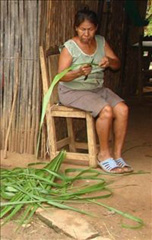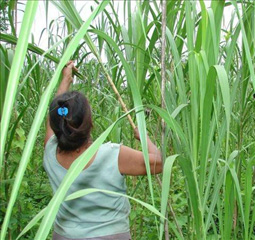Jedando
Maasai Beaded Double Circle Dangle Earrings- Mango Orange and Black-3.5"L
Maasai Beaded Double Circle Dangle Earrings- Mango Orange and Black-3.5"L
No se pudo cargar la disponibilidad de retiro
Black and orange Maasai bead double-circle drop earrings are fun and lightweight.
- Hypoallergenic hooks.
- 3.5-inch drop length
- Larger circle: 1.5-inches wide
- Smaller circle: 1.125-inches wide
Maasai beadwork embodies the whole of Maasai culture representing beauty, strength, tradition, warriorhood, social status and their deep love and devotion for their cattle. The age old artform is practiced by women of the village who learn from their mothers, who learned from their mothers. The women take small glass beads that are laid out on trays and string onto clear threading. From here the designs and beauty explode to create bracelets, earrings, and necklaces.
Did you know each color has a symbolic meaning for the tribe?
- Red stands for bravery, unity and blood. The red is for the slaughtered cow.
- White is for the peace, purity and health.
- Blue, signifies the energy and the sky. They believe that with the rainfall it is able to feed their cattle’s and provide proper infrastructure for them.
- Orange and Yellow reflect hospitality. Visitors are served cow’s milk from orange gourds.
- Green like the earth symbolizes health and land.
- Black represents the people and the struggles they endure.
All jewelry is crafted by women of the Maasai tribe in rural Kenya. Fair Trade.
Share
About the Artisans
About the Artisans
 Joyeria Semilla meaning Seed Jewelry is a small fair-trade workshop in the Andean town of Villa de Leyva, Colombia. Girasol Taborda, a local artisan and social entrepreneur, started the workshop in the mid-1990s.
Joyeria Semilla meaning Seed Jewelry is a small fair-trade workshop in the Andean town of Villa de Leyva, Colombia. Girasol Taborda, a local artisan and social entrepreneur, started the workshop in the mid-1990s.
Joyeria Semilla’s objective is three-folds; to create new jobs, revive Colombia's handicrafts sector and to motivate locals to better manage their natural resources. The organization works primarily with socially and economically disadvantaged youths, single mothers and people with disabilities in the area. The company offers free training in product design, technical training and marketing to new members. Joyeria Semilla has trained them in the craft of jewelry-making.

Caña Flecha or “Gynerium Sagittatum” is a locally found palm tree in the regions of the Caribbean coast. The leaves from this plant are used for making jewelry, woven hats, bags and baskets. The Zenú Indians were and their descendants inherited the tradition of picking veins of the green palm leaf for weaving. These veins were made into woven hats and other products for their personal use.
The Zenú culture is said to have existed between 200BC to1600AD. With the arrival of the colonizers in the 16th century, the indigenous community declined of unknown reasons. Today a very small population remains that claims the inheritance of the almost extinct Zenú tribe. Known for their skills in the construction of major waterworks, canals and irrigation system along with being skilled goldsmiths, examples of their accomplished craftsmanship are found in various museums around the world. Their larger means of subsistence were hunting, farming, fishing and trading.
Caña Flecha is found in abundance in the region, and hence makes for a sustainable and naturally available raw material for these products. Every bit of the plant is utilized – from using in building walls and roofs in houses to food for cattle and medicinal purposes. It is from the central vein of the leaf that the fibers for weaving are obtained. After the hard surface is peeled off, the fibers are left in the sun to dry and undergo a natural tinting process; these fibers are barely about 1 millimeter in thickness and hence call for a lot of skill and patience to weave with. The dried fibers are then processed for natural coloration - some are boiled with lemon to whiten them and some are treated with mud and boiled with plantain leaves to blacken them. The designs are based on ancient motifs and mathematical representations, which are inspired by the early Zenú culture.




